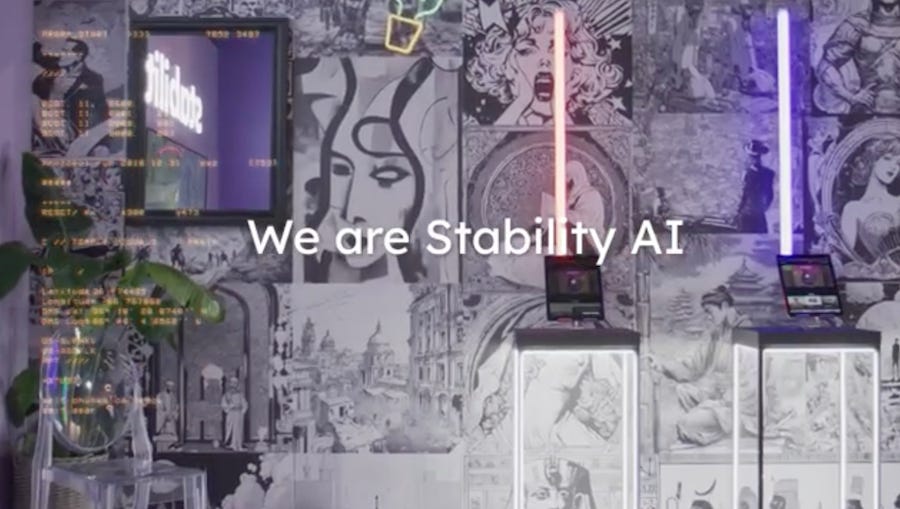Stability AI Gets a Rescue Package That Could Save Stable Diffusion's Future
Sean Parker joins the board along with a new CEO
Stable Diffusion was once and likely still is the most widely used text-to-image AI foundation model. It rose to prominence in 2022 as an open-source alternative to OpenAI’s DALL-E, Midjourney, and other proprietary offerings. The control and cost benefits of Stable Diffusion’s open-source model made it attractive for many software makers who wanted to add AI-enabled image generation to their products.
The core technology behind Stable Diffusion is Latent Diffusion, which was developed at Ludwig Maximilian University in collaboration with Runway. However, Stability AI became the driving force behind model advances, new features, and adoption. The company delivered updates to the open-source model and also provided a hosted service for users who wanted easy access to the software.
Unfortunately, Stability AI was plagued by poor economic performance, rapid staff turnover, and controversies that undermined investor confidence in the company and its founder, Emad Mostaque. Synthedia wrote in November 2023:
If Stability AI didn’t have the funding, personnel, and product doubts hanging over it, the company might have already hit the aspirational $4 billion valuation. The AI image generation segment is not as large as LLMs, but it is important and large enough to matter. Canva and Picsart users have created millions of images courtesy of Stable Diffusion-powered features. They are not alone.
The more salient question is how many companies are or will engage Stability AI for its value-added services. Today, it offers convenience on top of a free product that is not terribly hard to operate…Stable Diffusion has a large market share and developer ecosystem but there is no guarantee Stability AI will benefit from that earlier work.
….
OpenAI’s [November 2023] debacle looked like a comedy. Stability AI’s turmoil may well become a tragedy without swift changes or the arrival of a white knight.
New CEO + New Funding
This past week, a white knight arrived with a cash infusion, a new CEO, and a famous Facebook and Napster alumnus. According to The Information:
Prem Akkaraju, former CEO of visual effects company Weta Digital, will step into the role, according to a person involved in the decision.
The 51-year-old Akkaraju is part of a group of investors including former Facebook President Sean Parker that has stepped in to save Stability with a cash infusion that could result in a lower valuation for the firm, which develops products that use Stable Diffusion, an open-source AI image generator.
Mostaque stepped down from his board seat and CEO position in March. Many viewed this as necessary before new investors would come in to rescue the company. Shan Shan Wong, former Stability AI COO, and Christian Laforte, former CTO, took over as co-CEOs after Mostaque’s departure. Their LinkedIn profiles still list each of them as Interim co-CEO.
The new CEO does not have a notable background in AI, but Weta Digital (aka Weta FX) is a special effects agency that has worked on films ranging from The Hobbit and Avatar to the Avengers and Guardians of the Galaxy. That suggests Akkaraju fits Stability AI’s target customer profile. Stable Diffusion, Stable Video Diffusion, and Stable Audio Diffusion are all tools that visual effects creatives and agencies could employ in their daily work.
Stability AI has many technology assets and many users of the core text-to-image model. It also has a large staff of AI researchers, who may present significant value on their own. Maybe a film industry veteran and Sean Parker can help the one-time unicorn get back to a valuation of $1 billion.
Many thanks to our title sponsor.
Anthropic Sonnet 3.5 Sets New Benchmark Standards
Anthropic released a new AI foundation model today. Claude 3.5 Sonnet is the latest iteration of the large language model (LLM) that has morphed into a multimodal AI model that includes capabilities around language and images. The new offering arrived less than four months after the introduction of the Claude 3 model family, which was among the first to…
Runway To Take on OpenAI's Sora with Enhanced Quality and Custom Models
Runway announced its new Gen-3 Alpha model that features more expressive faces, sharper video, and more control over style and motion than the company’s earlier generation models. However, Runway is not promising minute-long generative AI videos like OpenAI.






Can Stable Diffusion exist without Stability AI, or is interdependence the order of the day?